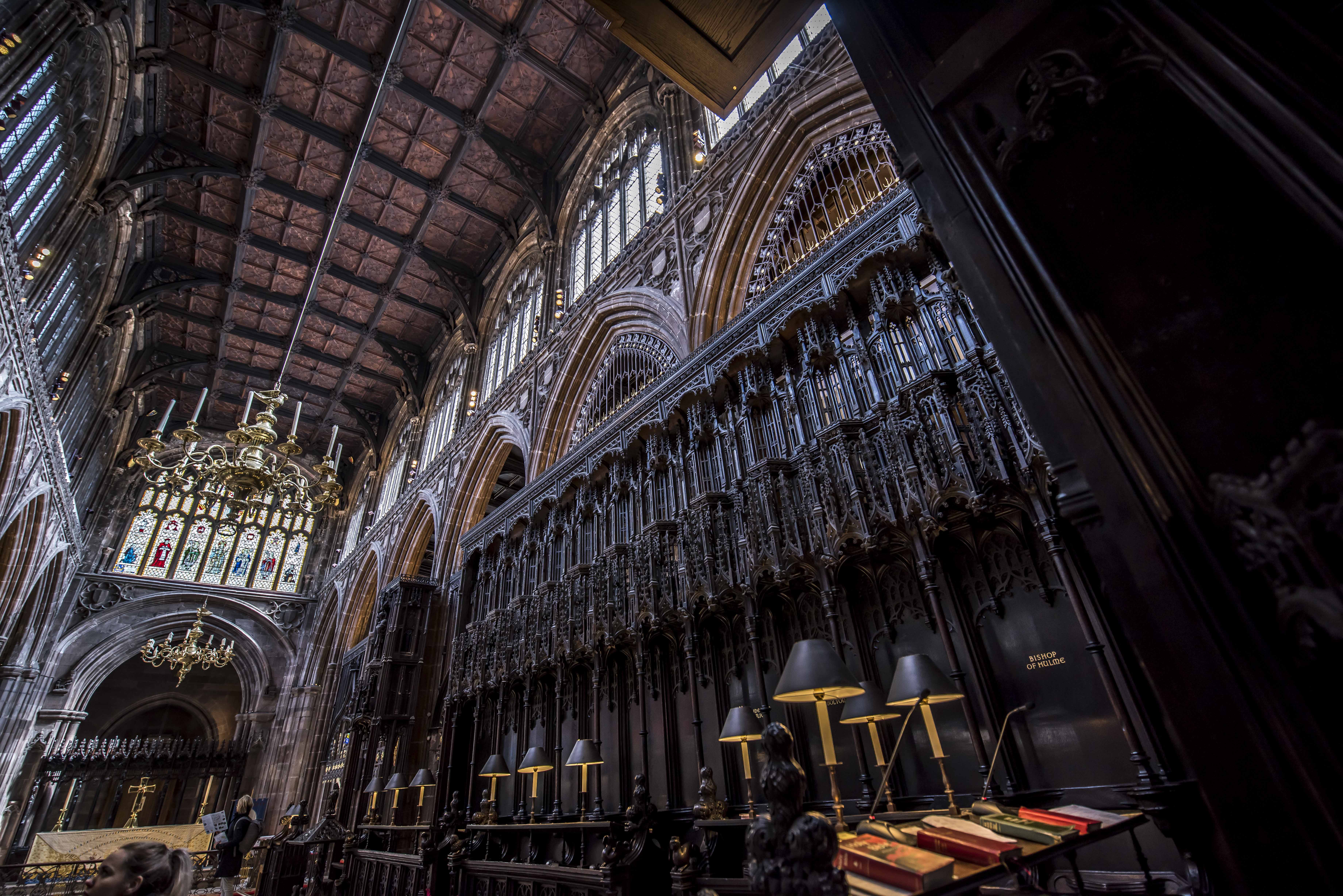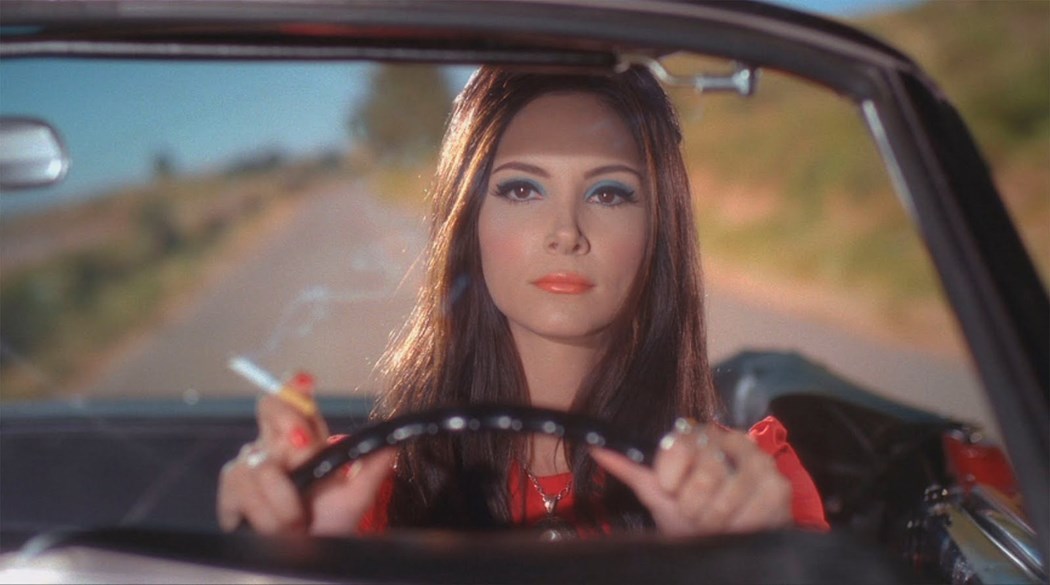When we were brainstorming venues to host this year’s Northern Soul Awards, there was one building at the top of our list – the iconic Manchester Cathedral. We’d thrown around various ideas but there was only ever one contender for the crown.
 Where else might you find medieval quires and ancient archives, bees on the roof and kangaroos carved on thrones? It’s a truly magnificent building. When I arrive, there are groups of tourists milling around, taking photographs of the sun shining through the beautiful stained-glass windows, and a choir practising towards the front of the building. Now, I’m not a religious person but there’s nothing quite like sitting quietly in a historical church, listening to hymns, to make you feel like there might just be something out there.
Where else might you find medieval quires and ancient archives, bees on the roof and kangaroos carved on thrones? It’s a truly magnificent building. When I arrive, there are groups of tourists milling around, taking photographs of the sun shining through the beautiful stained-glass windows, and a choir practising towards the front of the building. Now, I’m not a religious person but there’s nothing quite like sitting quietly in a historical church, listening to hymns, to make you feel like there might just be something out there.
Manchester Cathedral has been centre stage in its city’s history for nearly 600 years. In 1421, Henry V signed a royal charter granting permission for a collegiate (college) church to be built. “When you come into this place as a simple human being, mortal beings that we are, you do realise that you end up passing through this place in the blink of an eye,” says Anthony O’Connor, director of fundraising and development at Manchester Cathedral. “Where you’re standing right now is the birthplace of Manchester and Salford. Both cities were founded on this spot, which is a very historic spot within this great city of ours.”
There has been a church on this site since approximately 700 AD. O’Connor explains: “The first church was a little Anglo-Saxon church which was built out of wood.” 
Back then Manchester was in complete and utter dense forest, surrounded by trees which were used to construct buildings. “That little Saxon church stood here for about 800 years and then Henry V, when he became King, wanted to establish a church in the North of England. So the church was commissioned. Margaret Beaufort (Countess of Richmond and Derby) – who is buried in Westminster Abbey – she was like the Dragon’s Den of the day, so she put up the money for the structure that you see here now. We’ll be celebrating our 600th anniversary in 2021.”
As we stand in the vast nave – the central part of the church and the major public space – I start to think about the many people throughout history who have stood on the same spot. Old buildings have this way of conjuring up these thoughts – it’s something about the feel of the place, I suppose. Not to go all The Sixth Sense but you can almost see them.
“This is built very much in the French style,” continues O’Connor. “[The Cathedral was built] not long after the Norman conquest and a lot of churches and buildings in this country had a major French influence. If you look outside to the garden, you could be looking at parts of Notre Dame Cathedral in the centre of Paris. We have the widest nave here than any cathedral in Northern Europe which lends itself very well to events and we’re honoured that the Northern Soul Awards will be coming to Manchester Cathedral later on this year.”
 An average dinner in the Grade I listed cathedral can accommodate up to 600 people. “The kitchen goes on the south side and we hold the pre-dinner drinks reception down in the North side,” says O’Connor. “The tower is older than the city of Liverpool.”
An average dinner in the Grade I listed cathedral can accommodate up to 600 people. “The kitchen goes on the south side and we hold the pre-dinner drinks reception down in the North side,” says O’Connor. “The tower is older than the city of Liverpool.”
O’Connor moved to Manchester Cathedral several years ago primarily to raise money for a new organ (“Events I do as a side-line,” he says). The original was demolished when it was hit by a German landmine on December 22, 1940 as part of The Blitz in Manchester during the Second World War.
“The original organ that stood on that medieval screen was completely destroyed, it fell to the ground. And for 75 years really, we’ve been without an organ. It’s a Stoller organ and cost us £2.6 million and we’re very grateful to Sir Normal Stoller and his trust for putting up a major part of the money to actually build that.”
The Stoller Organ, built by Tickells, is designed with a mechanical key action and has better access for tuning and maintenance. Whereas the previous organ took up space in the aisles, the Stoller Organ is mounted on the screen as the pre-war organs were.
O’Connor continues: “We’ve also introduced a new lighting scheme in the last year, at a cost of just under a £1 million, and cleaned the stone and the fabric.”
For years, the stone in the cathedral was dark. “That was part of industrial Manchester but what we’ve done is cleaned it now and you can see that it’s brought the lovely pink out in the sandstone. There’s a lovely warmth to the colour and you can see some of the detail in the carvings.”
Next, we walk through to the quire – yes, the choir sing in the quire (“It took me a few years to get my head around that,” admits O’Connor). “This is also medieval and dates back 600 years and, thank God, the German landmine that hit us didn’t do too much damage to this part of the quire.” 
From inside the quire you can see the other side of the magnificent organ which is markedly different to the contemporary side visible from the nave. “The east side of the organ here is a little bit more traditional and the pipes are gilded which is beautiful. Also, within the quire, we have these beautiful misericords which, again, date back to medieval times and the carvers could carve their own seats.
“Imagine 600 years ago, you turned up for work on a Monday morning and there’s no electricity then, is there? And no tools available like there are today. So, 600 years ago they lined up all the oak trees and for the next 100 years they carved what you see here. You could probably say that four to five generations would have been involved in carving these.”
The roses adorning the top of the misericords are so delicate and beautiful that it’s hard to believe that each bunch was carved from a single tree. “In order to alleviate the stress and anxiety, and yes, they did have that back then, they were allowed to carve these beautiful seats. These seats, if you pick them up, all depict scenes that people would have been quite familiar with years ago.”
 I watch as O’Connor lifts each seat in the quire to reveal more ornate carvings. “You’ve got George and the Dragon, farmyard scenes, pigs, and then over here is the oldest depiction of two people playing backgammon in this country.”
I watch as O’Connor lifts each seat in the quire to reveal more ornate carvings. “You’ve got George and the Dragon, farmyard scenes, pigs, and then over here is the oldest depiction of two people playing backgammon in this country.”
You’d never know that was hiding under a seat in Manchester.
Towards the top of the quire lies the seat of the Bishop of Manchester (it’s incredibly fancy) called the cathedra. “If I was to take this seat out of here and stick it in Manchester Arndale, that would then become Manchester Cathedral.”
Can you imagine? The Bishop sat on the Cathedra outside Topshop. It sounds like a joke – when is a cathedral not a cathedral? – and, I must admit, I never knew that a Cathedral was only given its title when it contained the Bishop’s seat. O’Connor says: “We became a cathedral in 1847, so we were the first cathedral carved out of the Industrial Revolution which saw the population explode in this country. Manchester was originally carved out of the diocese of Chester. Prior to Chester, we were in the diocese of Litchfield which shows how much the city expanded.”
“So, the Midlands existed before the North?” I joke – I’m a Midlands girl. I guess that alters the whole “where does the North begin?” debate.
 “The first Bishop of Manchester, James Moorhouse, was a Sheffield lad. He became a priest and was sent to Australia – voluntarily – and arrived in Melbourne, which at the time was the capital of Australia, and while he was there he built Melbourne cathedral which still stands today.
“The first Bishop of Manchester, James Moorhouse, was a Sheffield lad. He became a priest and was sent to Australia – voluntarily – and arrived in Melbourne, which at the time was the capital of Australia, and while he was there he built Melbourne cathedral which still stands today.
“Then, Moorhouse was brought back to England where he became the first Bishop of Manchester. In 1847, they had to build the seat and they built it in sympathy with the quire, but you can see the roses are not as intricate as they were 600 years ago. They had to get the seat ready for his return which, as there was no Qantas or British Airways back then, it would have taken 12 to 16 weeks, but they carved two kangaroos into the chair so, when he was sitting here, he could think of his days Down Under.”
Next, it’s on to the Regimental Chapel where we’ll be hosting the Northern Soul Awards drinks reception.
“In my time here at the cathedral, we’ve done a lot of events and try to open up the cathedral to great swathes of the community. We’ve had some momentous events here,” O’Connor says proudly. “Elbow in Concert was many years ago but that was just incredible. On the back of that, MTV bought MTV Crashes Manchester with Alicia Keys which was unbelievable, and, I would say, that throughout the year, we do several events.
“Last weekend, we had the lovely gin festival here over three days. We do a series of concerts so over the next few weeks we’ve got The Slow Readers Club, Gavin Jones, G4. We’ve got a wine fair coming up and a series of gala dinners – including the Northern Soul Awards – and then in December we lend the cathedral to support several Greater Manchester charities such as Henshaws for the Blind and St Ann’s Hospice.
 “We also have a major service here on May 22 to commemorate the bomb attack in Manchester last year, so all the families and dignitaries will be here to mark that very sad day.”
“We also have a major service here on May 22 to commemorate the bomb attack in Manchester last year, so all the families and dignitaries will be here to mark that very sad day.”
O’Connor is also director for Manchester Cathedral’s own charity, Volition Community, which seeks to identify roles, projects and areas of community action where unemployed people can become a volunteer.
“I like to think that what we do here, if you’re a person of faith or you’re a person of no faith, you should be able to come into this building and get something out of it. They are the kind of values that we hold.”
(All images by Chris Payne)
To view Northern Soul’s gallery of images from Manchester Cathedral, click here.
 As part of the Northern Soul Awards 2018, we will be raising money for charity. Last year, at the inaugural awards, we raised hundreds of pounds for charity and we aim to better that total this year. In keeping with the venue for this year’s awards, Manchester Cathedral, the nominated charity is Volition, an innovation in volunteering and employability. Volition bring cathedrals, civic leaders, partners and business together to open up job opportunities for local unemployed people who are Volition volunteers. It does amazing work. You can find out more about it via this link.
As part of the Northern Soul Awards 2018, we will be raising money for charity. Last year, at the inaugural awards, we raised hundreds of pounds for charity and we aim to better that total this year. In keeping with the venue for this year’s awards, Manchester Cathedral, the nominated charity is Volition, an innovation in volunteering and employability. Volition bring cathedrals, civic leaders, partners and business together to open up job opportunities for local unemployed people who are Volition volunteers. It does amazing work. You can find out more about it via this link.











